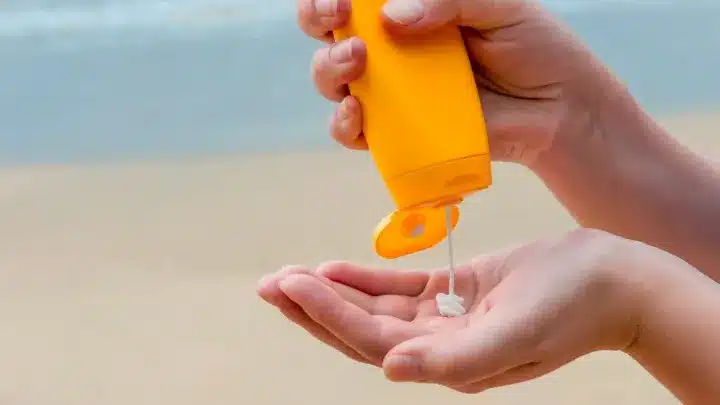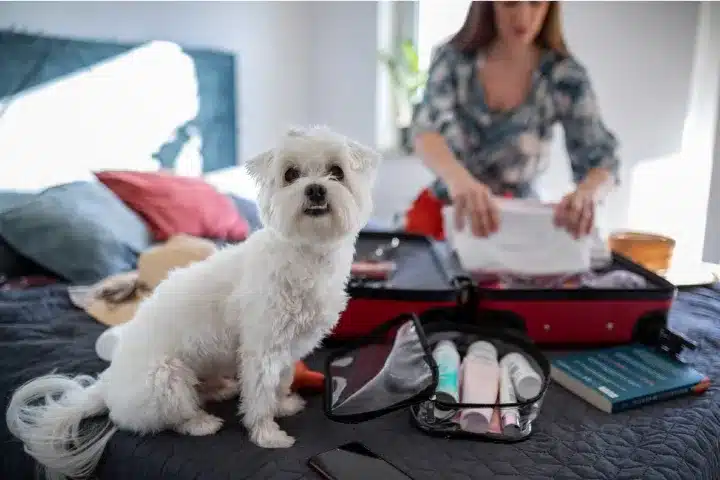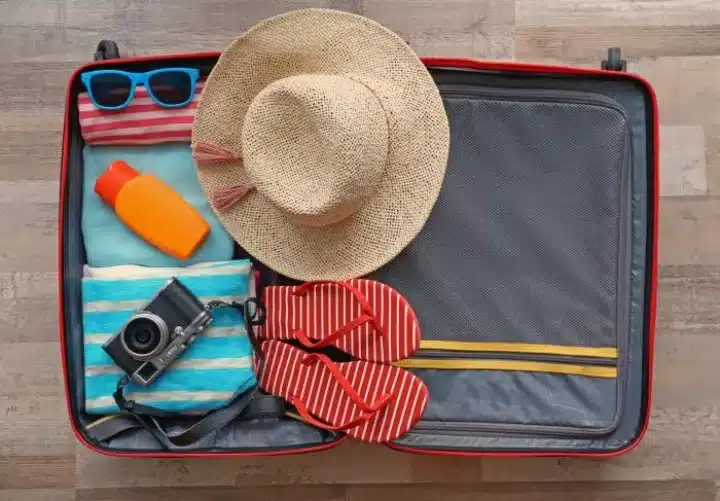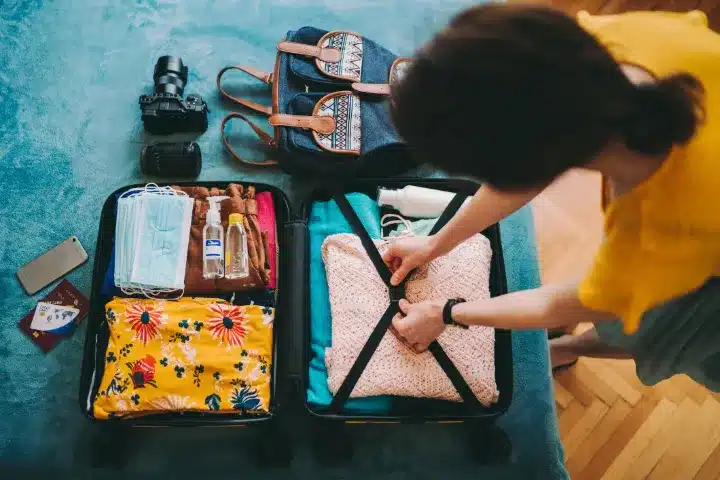Traveling can be a challenge, and packing correctly is crucial. Ever wondered if can you pack sunscreen in checked luggage?
We’ve all had our doubts about what is allowed and what’s not when traveling. But, how do you protect your skin from the harsh sun if you’re traveling to a sunny destination and you cannot carry your sunscreen?
Imagine being able to travel without worrying about your skincare, especially sunscreen. Our in-depth blog post will answer this burning question – Can you pack sunscreen in checked luggage?
Don’t let your doubts hold you back. Tap into our blog post to plan your packing efficiently and prepare for your next sunny vacation.
Understanding Sunscreen Essentials
Before delving into the intricacies of packing sunscreen in checked luggage, let’s establish a solid foundation by understanding the basics of sunscreen. Sunscreen, commonly available in lotion, spray, or gel forms, is designed to shield our skin from the damaging effects of ultraviolet (UV) radiation emitted by the sun.
UV rays can lead to various skin issues, including sunburn, premature aging, and an increased risk of skin cancer. As a travel essential, sunscreen is vital for protecting your skin’s health while exploring new horizons.

Sunscreen products work by incorporating ingredients that act as filters, reducing the amount of UV radiation that reaches the skin. There are two main types of sun-protective ingredients: organic (chemical) and inorganic (physical) filters. Organic filters absorb UV radiation and convert it into a small amount of heat. In contrast, inorganic filters reflect the UV radiation away from the skin.
It’s important to note that no sunscreen can block 100% of the sun’s rays, and it should not be used as a way to prolong sun exposure. Instead, it should be used in conjunction with other protective measures like wearing hats, sunglasses, and protective clothing, and seeking shade during the peak hours of UV radiation, usually between 10 a.m. and 2 p.m. It’s also important to apply a generous amount of sunscreen on all exposed skin and reapply it every two hours, or immediately after swimming or excessive sweating.
Choosing the right sunscreen requires understanding the Sun Protection Factor (SPF) that measures the fraction of sunburn-producing UV rays that reach the skin. The American Academy of Dermatology recommends using a sunscreen with an SPF of 30 or higher, which blocks 97 percent of the sun’s UVB rays. It’s also important to choose a sunscreen labeled “broad-spectrum,” as it protects against both UVA and UVB rays.
Remember, while sunscreen is a crucial tool in the fight against skin cancer and premature aging, it’s not a silver bullet. It should be part of a larger strategy of sun protection, especially for those who spend a lot of time outdoors.
Types Of Sunscreen
Sunscreen plays a pivotal role in maintaining healthy skin, offering protection from harmful UV rays that can lead to skin damage or even cancer. There are several types of sunscreens that cater to different skin types and preferences.
Chemical Sunscreens
Chemical sunscreens are one common type, characterized by their ability to absorb UV rays before they can penetrate the skin. The active ingredients in these sunscreens are often carbon-based compounds, such as oxybenzone, avobenzone, and octinoxate. The primary advantage of chemical sunscreens is that they are typically lightweight, easy to apply, and do not leave a white residue on the skin. However, they have been implicated in some environmental concerns, particularly their potential to harm coral reefs.

Physical sunscreens
Physical sunscreens, also known as mineral sunscreens, work differently. Rather than absorbing UV rays, these sunscreens reflect them away from the skin. They contain active mineral ingredients such as zinc oxide or titanium dioxide, which are generally considered safer for both the skin and the environment. Physical sunscreens are often recommended for those with sensitive skin as they tend to be less irritating. However, they can be more difficult to rub in and may leave a white cast on the skin.
Hybrid sunscreens
Hybrid sunscreens represent a blend of chemical and physical sunscreens, aiming to offer the benefits of both types. They contain a mix of chemical UV filters and mineral ingredients. These sunscreens are designed to provide broad-spectrum protection while being easier to apply and less likely to leave a white residue than pure physical sunscreens.
Specialty Sunscreens
Lastly, there are specialty sunscreens tailored for specific conditions or needs. For instance, sports sunscreens are designed to be sweat and water-resistant for those engaging in vigorous activities. There are also sunscreens formulated specifically for children’s delicate skin, or for individuals with certain skin conditions such as rosacea or acne.
Regardless of the type, it’s crucial to choose a broad-spectrum sunscreen that protects against both UVA and UVB rays and to apply it correctly and consistently for maximum protection.
Things To Consider Before Buying Sunscreen
When choosing a sunscreen, the first thing you’ll likely notice is the Sun Protection Factor (SPF). This measure indicates how well the sunscreen can protect your skin from harmful UVB rays, which are primarily responsible for sunburn and skin cancer. SPF 15 blocks about 93% of UVB rays, SPF 30 blocks 97%, and SPF 50 blocks 98%. However, a higher SPF doesn’t mean you can stay out in the sun longer without reapplying. No sunscreen can block 100% of UVB rays, and reapplication every 2 hours is recommended.

Consider Broad-Spectrum Protection
Apart from UVB, UVA rays also have detrimental effects on the skin by causing premature aging and contributing to skin cancer. Thus, ensure your sunscreen offers broad-spectrum protection, which means it shields your skin from both UVA and UVB rays. This will keep your skin healthy and youthful by preventing both sunburn and premature aging.
Look for Water Resistance
If you’re planning to swim or sweat, it’s crucial to choose a sunscreen labeled as ‘Water-Resistant’. This means the sunscreen will stay effective on wet or sweaty skin for a certain amount of time (usually 40 to 80 minutes). After that, you’ll need to reapply. Remember, no sunscreen is entirely waterproof or sweatproof.
Check the Ingredients
Some sunscreens contain ingredients that might cause skin irritation or allergic reactions. Therefore, it’s important to check the label for any ingredients you know you’re sensitive to. Physical (or mineral) sunscreens with ingredients like zinc oxide and titanium dioxide are usually well-tolerated by most skin types, including sensitive skin.
Choose the Right Form
Sunscreen comes in various forms like creams, lotions, sprays, gels, and sticks. Creams are best for dry skin and the face, lotions for application over large areas, and sticks for around the eyes. Gels and sprays are good for hairy areas. However, if you use a spray, make sure to rub it in so you don’t miss any spots.

Consider Your Skin Type
Finally, consider your skin type while choosing sunscreen. If you have oily skin, go for a non-comedogenic sunscreen that won’t clog your pores. Those with dry skin should look for a moisturizing sunscreen with ingredients like glycerin or aloe. If you have sensitive skin, choose a fragrance-free and hypoallergenic formula.
Can You Pack Sunscreen In Checked Luggage?
The short answer is yes, you can pack sunscreen in your checked luggage. The Transportation Security Administration (TSA) and most airlines permit the inclusion of sunscreen products in both checked and carry-on baggage. However, there are a few considerations to keep in mind to ensure a hassle-free experience at airport security checkpoints.
Regulations and Guidelines
- Container Size: Sunscreen products in liquid or gel form are subject to the TSA’s liquids rule. Each container must be 3.4 ounces (100 milliliters) or less and placed in a quart-sized, clear, resealable plastic bag. These bags are limited to one per passenger and must be presented separately during the security screening.
- Travel-Sized Containers: To adhere to the TSA’s regulations, it’s advisable to purchase travel-sized sunscreen containers that meet the 3.4-ounce limit. Many reputable sunscreen brands offer products in these convenient sizes, ensuring compliance with security regulations.
- Spray Sunscreens: If you prefer spray sunscreens, it’s important to choose ones that are TSA-compliant. Aerosol sunscreen containers must be within the 3.4-ounce limit, and they must also adhere to the airline’s specific policies on aerosols.
- Non-Liquid Sunscreen: Solid sunscreen sticks and powders are generally not subject to the TSA’s liquids rule. However, it’s recommended to check with your airline and the TSA’s official guidelines to confirm the acceptability of these products.
- International Travel: Different countries may have varying regulations regarding sunscreen. It’s crucial to research the rules of your destination country to ensure your sunscreen complies with their guidelines.
Packing Sunscreen: Best Practices
- Organize and Secure: Place your sunscreen containers in a clear, resealable plastic bag to keep them easily accessible during security screening. This not only streamlines the process but also prevents spills that could potentially damage your belongings.
- Layering Technique: To prevent leakage, unscrew the cap of each sunscreen container, place a small piece of plastic wrap over the opening, and then screw the cap back on. This extra layer of protection can help safeguard your luggage against unexpected spills.
- Protective Packaging: To minimize the risk of breakage, consider placing your sunscreen containers in the center of your luggage, surrounded by soft items like clothes or towels. This acts as a cushion against potential impacts during handling.
- Consider Carry-On: While sunscreen can be packed in checked luggage, you may also opt to include a small container in your carry-on bag. This ensures you have immediate access to sunscreen upon arrival or during layovers.

Benefits Of Packing Sunscreen In Checked Luggage
Protection from Harmful UV Rays
Packing sunscreen in your checked luggage ensures that you are prepared to protect yourself against the harmful effects of the sun’s ultraviolet (UV) rays upon reaching your destination. Prolonged exposure to these rays not only causes sunburn but also contributes to premature skin aging and increases the risk of skin cancer. Having your own trusted brand of sunscreen with you mitigates these risks, promoting skin health.
Cost Saving
Buying sunscreen after landing can be pricey, especially in popular tourist destinations where prices are often inflated. Having it already packed in your luggage can save you from these unnecessary expenses, allowing you to allocate your resources to experiences and memories on your holiday.
Convenience
Packing sunscreen in your checked luggage offers convenience. It eliminates the need to find a store upon arrival, which can be particularly tricky in unfamiliar locations or during late hours. You can start your trip right away, knowing that you have your sunscreen ready.
Assurance of Quality
Having sunscreen in your checked luggage gives you the certainty of its quality. You can pack your preferred brand that you know works well for your skin type, and which complies with your home country’s safety and quality standards. This can be particularly beneficial if you are traveling to a destination where the quality of such products might vary.

Allows for Carrying Larger Sizes
While there are restrictions on the size of liquids in carry-on luggage, these do not apply to checked luggage. This allows you to pack a larger size of your preferred sunscreen, ensuring you don’t run out midway through your vacation.
Respect for Environmental Regulations
Certain destinations, especially marine protected areas, have strict regulations about the type of sunscreen you can use to protect coral reefs from chemical harm. Packing eco-friendly sunscreen in your checked luggage ensures compliance with these regulations, contributing to the preservation of these delicate ecosystems.
FAQs
Is it permissible to pack sunscreen in checked luggage?
Yes, it is entirely permissible to pack sunscreen in your checked luggage when traveling by air. The Transportation Security Administration (TSA) in the United States allows passengers to carry sunscreen in their checked bags without any restrictions in terms of the quantity or size of the container. This means you can pack full-sized bottles of sunscreen in your checked luggage without any issues.
However, if you wish to carry sunscreen in your carry-on bag, the standard TSA liquid rules apply. This means the sunscreen container should not exceed 3.4 ounces (100 milliliters) and it needs to fit in a quart-sized, transparent, resealable plastic bag along with any other liquids, gels or aerosols you are carrying.
It’s also worth noting that while aerosol sunscreens are allowed in both checked and carry-on bags, they are subject to the same size restrictions as mentioned above in carry-on bags. In checked bags, aerosol containers should not exceed 18 oz (507 grams) per container or 70 oz (2 kg) total per passenger.
Remember to check the rules and regulations of the specific airline you’re flying with, as some airlines may have their own restrictions or guidelines when it comes to packing liquids in luggage. If you have a specific brand or type of sunscreen that you prefer, packing it in your checked luggage is a safe bet to ensure you have it available during your travels.

Are there any restrictions on the size of the sunscreen container in checked luggage?
In terms of checked luggage, the Transportation Security Administration (TSA) does not specify any size restrictions for sunscreen containers. This means you are typically free to pack full-sized bottles or aerosol cans of sunscreen in your checked bags. However, the TSA does limit the total quantity of aerosols to 70 oz (2 kg) per passenger, and each aerosol container should not exceed 18 oz (507 grams).
While the TSA regulations are generally followed by most airlines, some may implement their own set of rules. Therefore, it’s always a good idea to confirm with your specific airline before your trip. It’s also important to remember that while it is acceptable to pack larger containers of sunscreen in your checked luggage, any sunscreen carried in your hand luggage must adhere to the standard TSA liquid rules, which limit container size to 3.4 ounces (100 milliliters).
What are the TSA guidelines for packing sunscreen in checked luggage?
The Transportation Security Administration (TSA) in the United has clear guidelines for packing sunscreen in checked luggage. According to the TSA, passengers are allowed to pack sunscreen in their checked bags without any restrictions on the quantity or size of the container. Therefore, you can safely pack full-sized bottles or aerosol cans of sunscreen in your checked baggage.
However, there are some limitations to be aware of when it comes to aerosol containers. Although aerosol sunscreens are allowed in both checked and carry-on bags, they are subjected to certain limits. The maximum allowed size of an aerosol container in a checked bag is 18 oz (or 507 grams). Moreover, the total quantity of aerosols you can carry should not exceed 70 oz (or 2 kg) per passenger.
While the above rules apply to all airlines operating under TSA regulations, some airlines may have additional restrictions or guidelines. Therefore, it’s always recommended to check with your specific airline before you pack.
In contrast, for carry-on luggage, the standard TSA liquid rules are applicable. This implies that the sunscreen container should not exceed 3.4 ounces (or 100 milliliters), and it should fit in a quart-sized, transparent, resealable plastic bag along with other liquids, gels, or aerosols.
In all cases, these guidelines are designed to ensure the safety and security of all passengers, and it’s crucial to adhere to them when packing for your travels.
Can I pack spray sunscreen in my checked luggage?
Yes, you can certainly pack spray sunscreen in your checked luggage when traveling by air. The Transportation Security Administration (TSA) allows passengers to pack aerosol sunscreens, including spray sunscreens, in their checked bags without any specific restrictions on the size or quantity of the container. This means you are free to pack full-sized bottles or cans of spray sunscreen in your checked luggage.
However, it’s important to note that while there is no explicit restriction, the TSA does impose some limitations on aerosols in general. Each aerosol container in a checked bag should not exceed 18 oz (or 507 grams), and the total quantity of aerosols you can carry should not exceed 70 oz (or 2 kg) per passenger. These restrictions apply to all aerosols, including spray sunscreens.
Be sure to also check with the specific airline you are flying with, as they might have their own guidelines and restrictions when it comes to packing aerosols and liquids in your luggage. It’s always better to be prepared and aware of the rules to avoid any inconvenience during your travel.
Remember, if you plan on bringing spray sunscreen in your carry-on bags, the standard TSA liquid rules apply. This means the spray sunscreen container should not exceed 3.4 ounces (100 milliliters) and should fit in a quart-sized, clear, resealable plastic bag along with any other liquids, gels, or aerosols you are carrying.
Are certain types of sunscreen not allowed in checked luggage?
There are no specific types of sunscreen that are outright prohibited in checked luggage according to the Transportation Security Administration (TSA). Whether it’s in lotion, gel, or aerosol form, you are generally allowed to include it in your checked baggage. However, if the sunscreen comes in aerosol form, it’s subject to certain regulations. Each aerosol container in a checked bag should not exceed 18 oz (or 507 grams), and the total quantity of aerosols you can carry should not exceed 70 oz (or 2 kg) per passenger.
Remember, while the TSA provides a general framework of rules, individual airlines may have their own restrictions or guidelines. Therefore, it’s always recommended to check with your specific airline before packing. Certain foreign airlines or airports may also have additional restrictions, particularly concerning aerosols, so it’s important to check this if you’re traveling internationally.
While sunscreen is largely unrestricted in checked luggage, any sunscreen you bring in your carry-on luggage must comply with the TSA’s liquid rules. This means the container size must not exceed 3.4 ounces (or 100 milliliters), and it should fit in a quart-sized, transparent, resealable plastic bag with other liquids, gels, or aerosols.
Conclusion
Can you pack sunscreen in checked luggage? In conclusion, it is permissible and advisable to pack sunscreen in your checked luggage when traveling. While there are limitations on liquids in carry-on bags, checked luggage does not have the same restrictions, allowing travelers to pack larger containers of sunscreen. This ensures protection from harmful UV rays during your journey, especially in sunny destinations. Remember, it’s always better to have it and not need it than need it and not have it!